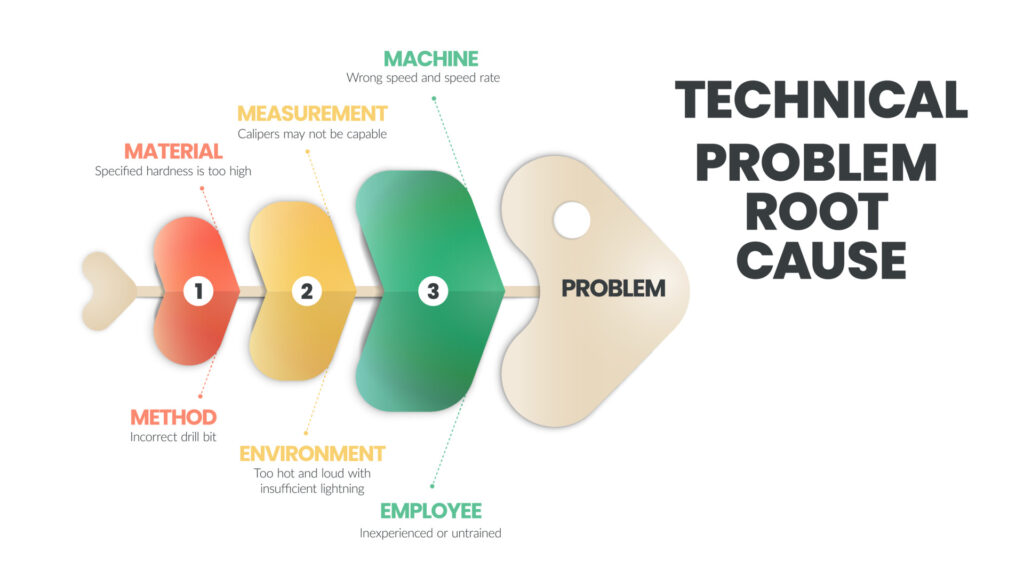Many small business owners get stuck on how to implement an effective root cause analysis because implementation needs to be planned in order to have an effective and successful outcome.
For continuous improvement in your business, it all starts with the engagement of and buy-in of your employees. After all, they are the human resources you will work with in the root cause analysis process!
This article reviews the step-by-step way to implement an effective root cause analysis from the planning stage.
Establish a Continuous Improvement Culture for an Effective Root Cause Analysis
To make the root cause analysis work effectively, you must establish a culture of continuous improvement within your business, otherwise you will keep repeating the same mistakes that create recurring problems.
This is more involved than you imagine, because it is so much more than making an announcement at a team meeting or coming up with a company jingle for the benefit of your customers!
Several strategies must work together to create a culture of continuous improvement. Your team should constantly be encouraged to be curious problem solvers with an improvement mindset.
They should be made to understand that identifying and solving issues is not about pointing fingers, but about growing together as a team.
Here are some of the strategies that you need to work on below. Check out the others and more detailed information in “How to Create and Maintain a Culture of Continuous Improvement“.
- Set clear goals for the team and the business.
- Owners and leadership team must consistently lead by example
- Encourage open and honest communication among team members.
- Identify Continuous Improvement Champions that can help drive the culture by encouraging their peers.
- Regularly assess your existing processes, procedures, work instructions, checklists and any other quality documents to see areas of improvement
- Empower team members to take ownership of their work processes and suggest improvements.
- Acknowledge individual and team efforts
- Develop ways to collect feedback from customers, clients, and team members.
By integrating these strategies into the backbone of your small business team, you can create an environment where continuous improvement becomes a natural part of the work culture, leading to enhanced efficiency, innovation, and overall success.
Select Suitable Improvement Projects
You do not have to go hunting for every tiny problem. Choose your projects wisely! Focus on issues that have a significant impact on the performance of your business or customer satisfaction and avoid those that will not add much value.
There is absolutely nothing wrong with starting with smaller problems first. You can later use the experience you acquire from this exercise when you confront your bigger issues.
Assemble a RCA Team for an Effective Root Cause Analysis
Assemble a diverse team with different perspectives and expertise. This could include employees from different departments or even involve customers or external consultants. The more the diversity of expertise, the better the strength of the team.
Gather Relevant Data and Information
Collect relevant data and facts related to the problem you’re investigating. This could be anything from sales figures and customer feedback to process flowcharts and employee feedback.
Apply the Relevant RCA Method and Tool
Choose the method that suits your specific problem and start uncovering those root causes. This is where a lot of small business owners become confused. Reach out for speedy assistance HERE
5 Whys For An Effective Root Cause Analysis
Ask “Why” until you hit the actual buried root cause. Keep an open mind in case you encounter some unexpected answers, and be willing to look beyond the initial obvious answers.

Fishbone Diagrams
Draw the fishbone and create a list of all potential causes under the 6 different categories. This helps you see the bigger picture and spot areas that require a deeper investigation.
Fault Tree Analysis Techniques
For more complex problems, the fault tree analysis should be your go-to-tool. It works like a roadmap leading you step by step to the underlying root causes.
Identify and Verify the Root Causes
When your detective work of data collection and analyses is complete, you must now identify the real root causes. This is where you separate perception from actuality Test your hypotheses and make sure you’ve hit the bullseye.
By this stage, you should have a deeper understanding and clarity of the problem, and you will be well on your way to developing effective and targeted corrective action solutions.
Create and Implement Meaningful Corrective Actions For a Good Root Cause Analysis
Now it is time to circle back to the team to brainstorm effective corrective action and timelines for their execution. As the Lead for the RCA, if you miss out this step and try to come up with your independent corrective actions, you might miss out some important details, so work with the team.
Conclusion – How to Implement an Effective Root Cause Analysis
Getting through a root cause analysis exercise requires time and human resources. Time is something many business owners typically do not have.
CONTACT US TODAY to assist your business efficiently and effectively with your root cause analysis, Better still, ask us about our “Train Your Team Program“.
Remember, RCA is not a one-time exercise but a continuous process of learning and growing. Embrace it, and reap the benefits of effective problem resolution.
Related Articles
- Why Root Cause Analysis Tools and Techniques are Important
- How to Implement an Effective Root Cause Analysis – Plan
- Why Root Cause Analysis is Important for Continuous Improvement
- Benefits of Integrating Root Cause Analysis and Quality Management
- How to Tackle Challenges in Root Cause Analysis – Common Ones
- How to Use Root Cause Analysis for Continuous Improvement
- How to Integrate Root Cause Analysis and Quality Without a QMS
- How to Reduce Risk in the Corrective Action Process
- Quality and Root Cause Analysis – How to Integrate Them
References
What is Root Cause Analysis (RCA)? ASQ https://asq.org › quality-resources › root-cause-analysis
